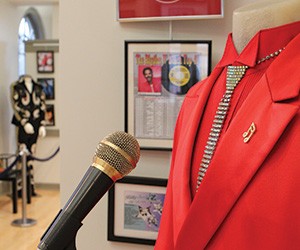Ingrained in Carolinas culture, creative expression is both a way of life and a way forward. Established in 1964, the North Carolina Arts Council became the first state agency focused on driving economic growth through the arts and humanities. South Carolina followed suit in 1967, forming the South Carolina Arts Commission, in its words “to build a thriving arts environment for the benefit of all South Carolinians.”
From treasured folk traditions to a vibrant modern scene, the arts in all forms are major shapers of the Carolinas’ experience—and ready inspiration for group agendas.
Sweet Sounds
Along with its Revolutionary War and textile history, Spartanburg, South Carolina signifies the state’s rich musical heritage. The Marshall Tucker Band and blues great Pink Anderson (who along with North Carolina bluesman Floyd Council inspired the naming of rock legends Pink Floyd) are among the local luminaries along the Spartanburg Music Trail, with performance venues including Hub-Bub’s Showroom Gallery and Performance Hall, Spartanburg Memorial Auditorium and the Chapman Cultural Center.
Located on the University of South Carolina campus in Columbia, the event-capable Koger Center for the Arts, seating 2,254 people, is home to the Columbia City Ballet and Columbia Classical Ballet. Greenville’s Peace Center is another versatile choice for Broadway shows, concerts and other productions.
Vibrant Charleston’s venues include the intimate Charleston Music Hall and historic Circular Congregational Church, featuring weekly performances ranging from gospel and Gershwin to Civil War camp songs. Jazz is huge, with the 20-piece Charleston Jazz Orchestra headlining a rich talent pool that plays all over town.
West of Charlotte in Transylvania County, the Brevard Music Center is among the nation’s premier classical music institutes and festivals. Founded in 1936, this Blue Ridge Mountain treasure stages 80-plus summertime concerts at venues including the 1,800-seat open-air lakeside Whittington-Pfohl Auditorium.
Just north of Charlotte lies Cabarrus County, home of NASCAR, where the North Carolina Music Hall of Fame enshrines greats such as Charlie Daniels, John Coltrane and Roberta Flack.
Buzzing Charlotte is home to the sprawling multi-venue NC Music Factory, featuring the 1,500-person Fillmore indoor music hall and 5,000-seat outdoor Time Warner Cable Uptown Amphitheatre. Pulsing too are Asheville, home to live music venues including Orange Peel and Asheville Music Hall, and Chapel Hill, home to the legendary Cat’s Cradle club.
Raleigh’s 80-plus live music venues range from the Red Hat Amphitheater on the Raleigh Convention Center campus to the intimate Lincoln Theatre. The city also has the rare combination of professional ballet, symphony, theater and opera companies in one place, at the Duke Energy Center for the Performing Arts.
With 2,700 seats, the Durham Performing Arts Center is the largest stage between D.C and Atlanta. Housed in a former auto shop, the new Motorco Music Hall is Durham’s largest club venue, while the redeveloped million-square-foot American Tobacco Campus incorporates live music and the arts.
Commanding the D.C.-Atlanta cultural corridor in another age was Greensboro’s 1927 Carolina Theatre, now a wonderful event-capable performing arts center. Lovingly restored, too, is Winston-Salem’s Stevens Center, originally a 1929 silent movie palace.
Active since 1858, Wilmington’s Thalian Hall Center for the Performing Arts is among the nation’s oldest theaters, offering function space in its grand ballroom and historic main stage. Close to the Wilmington Convention Center, the new Humanities & Fine Arts Center is the area’s largest and most technologically sophisticated performing arts center.
Since 1962, the group-capable Cape Fear Regional Theatre in Fayetteville has featured top-quality productions on its 327-seat main stage, with seasonal performances at an outdoor riverside amphitheater.
PageBreakExceptional Encounters
From rare treats to retail extravaganzas, the Carolinas are filled with cultural delights for groups.
In western North Carolina, Brasstown is home to the singular John C. Campbell Folk School. Established in 1925 to preserve the crafts, techniques and tools of Appalachian mountain people, this revered institution, following the Danish folk school (folkehojskole) model, offers festivals, concerts and hundreds of classes in art, music, dance, nature studies, photography and more.
Artful immersions also await in Asheville, including demonstrations by Southern Highland Craft Guild artists at the Folk Art Center, and tours of the Downtown Asheville Art District and historic River Arts District.
Founding home of the North Carolina Arts Council, Winston-Salem’s assets include the former home of tobacco baron R.J. Reynolds, now the preeminent Reynolda House Museum of American Art, and the Southeastern Center for Contemporary Art, former home of textile industrialist James G. Hanes.
Popularized as the “Smithsonian of the South,” Raleigh’s free-admission collection includes the North Carolina Museum of History, North Carolina Museum of Natural Sciences, and North Carolina Museum of Art, with its 160-acre outdoor Art Park.
In nearby Johnston County, hometown Hollywood screen legend Ava Gardner is remembered at her namesake museum. Hoops fans have the Carolina Basketball Museum in Chapel Hill, and racing fans the NASCAR Hall of Fame in Charlotte.
Famous, too, is Replacements, Ltd., in Greensboro, the attic project that grew into the world’s largest collection of dinnerware. Tours of the warehouse—housing 12 million pieces on the equivalent of eight football fields—are available along with meeting space. There is also the Hickory region’s renowned “20 Miles of Furniture” on Highway 321.
South Carolina’s own superior museum collection includes the Columbia Museum of Art, which was recently gifted a complete set of Andy Warhol’s silkscreens of Chairman Mao Zedong and will next feature a blockbuster exhibit focusing on Georgia O’Keeffe.
The world’s largest Andrew Wyeth watercolor collection resides at the Greenville County Museum of Art, and the Western Hemisphere’s largest religious art collection at the Bob Jones Museum and Gallery.
The natural world also comes alive in the Carolinas. In Myrtle Beach, groups can take boat tours of Brookgreen Gardens and its supreme outdoor sculpture collection, or go behind the scenes at the renowned South Carolina Aquarium’s Sea Turtle Hospital in Charleston.
Wilmington’s North Carolina Aquarium at Fort Fisher is known for its Enchanted by the Sea events, while the North Carolina Botanical Gardens in Chapel Hill ranks among the largest in the Southeast.



